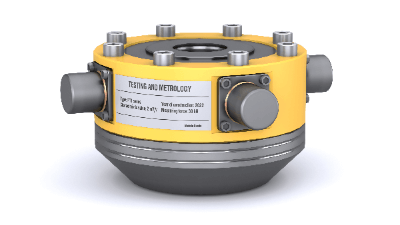What Is a Scale Load Cell?
 A scale load cell is a measuring instrument that converts a physical quantity, the magnitude of a load or force, into an electrical signal and extracts it as a numerical value.
A scale load cell is a measuring instrument that converts a physical quantity, the magnitude of a load or force, into an electrical signal and extracts it as a numerical value.
Strain gauges are mainly used as the sensing element for load or force. Strain gages are sensors that detect deformation of an object as a change in electrical resistance. To make a highly reliable measuring instrument, the output change of a strain gage in response to a load or force is adjusted so that the same conditions of load are applied and compared with a sensor of higher accuracy.
This process is called calibration and is essential for all measuring instruments. Scale load cells can be used to measure either static loads, in which a load of the same magnitude is applied continuously, or dynamic loads, in which the magnitude of the applied force varies continuously. Load cells are classified according to the direction of the load: tension/compression, tension, and compression.
Applications of Scale Load Cells
Scale load cells are widely used in equipment that measures the magnitude of force. Testing equipment such as Amsler-type universal testing machines, as well as industrial machines such as forging and presses, for which load is a manufacturing requirement, are among the applications.
Scale load cells are also used in sensors that measure moments, the ability of an object to rotate. In particular, 6-axis sensors that can simultaneously measure forces in three directions (xyz, y, and z) and moments that rotate an object around each axis are used in force-controlled robots that can perform sophisticated tasks.
Other than industrial machinery, another example is the rock anchor/earth anchor in the construction and civil engineering industry for civil engineering work. Scale Load Cells are used to measure the force applied to PC steel rods and wires that are actually under load in rock anchors and earth anchors.
Principle of Scale Load Cells
The principle of a scale load cell is to detect the deformation of an object as a change in electrical resistance. Strain gauges detect the deformation of an object due to force. Generally, when an object is pulled, it stretches and its thickness becomes thinner.
This deformation, in the case of an electric wire, makes it difficult for electricity to flow, i.e., the electrical resistance increases. The strain gage attaches a very thin wire to the surface of the part on which the load acts, and detects the deformation of the part as a change in the length and thickness of the wire as a change in electrical resistance.
Other Information on Scale Load Cells
1. Scale Load Cell and Load Cell
A scale load cell is, in its original meaning, a load cell. However, load cell is the name of a sensor of load, and a load cell by itself cannot display the measured load value. Therefore, a display meter is required to electrically connect the load detected by the scale load cell to the load cell, convert it into a load value, and display it.
Specifically, a strain amplifier plays the role of an indicator. The combination of a load cell and a scale load cell is sometimes referred to as a scale load cell. Various manufacturers produce a variety of products that combine load cells and scale load cells.
These products are called crane scales, force gauges (push-pull gauges), etc. In the broadest sense, they are tensile testers, pull testers, and force gauges. In a larger sense, tensile testers and stress testers are also scale load cells.
2. Crane Scale Load Cell
A crane scale load cell is a device attached to a truck to measure the weight of a crane’s suspended load. It does not use load cells or other load sensors, but converts the working pressure of the hydraulic motor of the hoisting equipment into a load.
The weight of the suspended load is displayed only when the hoisting device is hoisting, and is not displayed when the hoisting device is stopped, when it is being lowered, or during other operations. Another type of Scale Load Cell, which combines a load cell and an indicator, is called a Crane Scale.
This is used with overhead traveling cranes, etc. The scale is suspended from a hook on the crane, or a suspended load is suspended from the bottom of the crane scale, and the weight of the suspended object is measured.
3. Scale Load Cells for Presses
Scale load cells for presses are load cells. The load cell measures the load applied to the processed part during the actual operation of the press machine. The output of the load cell is converted from an analog voltage output to a digital output and the load value is displayed. Whenever analog-to-digital conversion is performed, a time of several milliseconds is required. If a scale load cell with a low response or low measurement frequency is used, problems can occur, such as not being able to fully measure the peak value or the measured load being unstable.